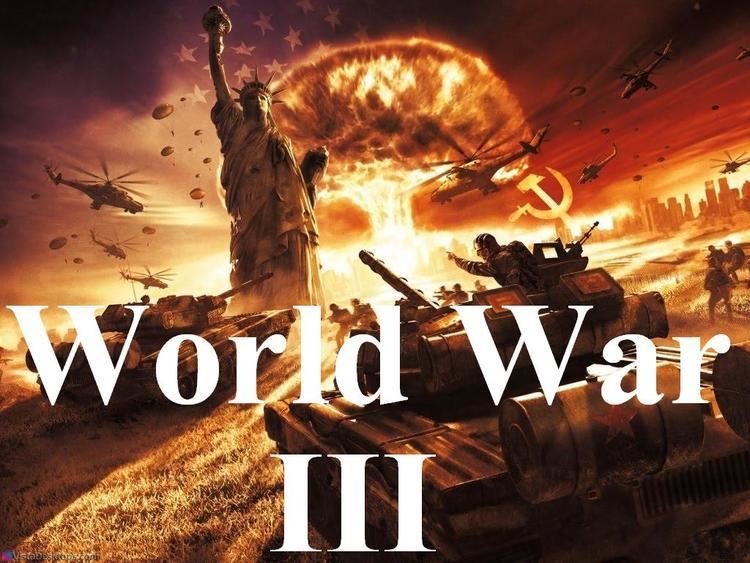 | ||
World war 3 could start this month 350 000 soldiers in saudi arabia stand ready to invade syria
World War III (WWIII or WW3) and Third World War are names given to a hypothetical third worldwide military conflict subsequent to World War I and World War II. The term has been in use since the end of World War II. Some have applied it loosely to refer to limited or smaller conflicts such as the Cold War or the War on Terror, while others have operated under the assumption that such a conflict would surpass both prior World Wars in both the level of its widespread scope and of its overall destructive impact.
Contents
- World war 3 could start this month 350 000 soldiers in saudi arabia stand ready to invade syria
- Military plans
- Operation Unthinkable
- Operation Dropshot
- Exercises Grand Slam Longstep and Mainbrace
- Operation Strikeback
- Exercise Reforger
- Seven Days to the River Rhine
- Exercise Able Archer
- Strategic Defense Initiative
- NATO nuclear sharing
- Historical close calls
- Cold War
- War on ISIL
- Multiple small wars as a third war
- Views on the likely outcome and definition of WW III
- References
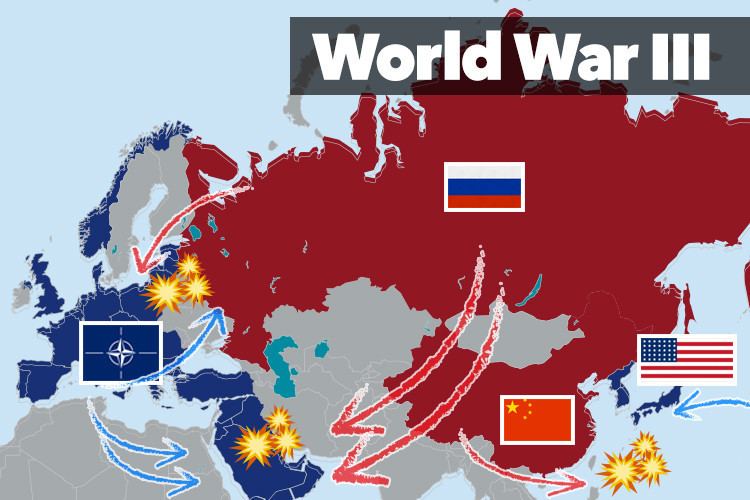
Because of the development and use of nuclear weapons near the end of World War II and their subsequent acquisition and deployment by many countries, the potential risk of a nuclear devastation of Earth's civilization and life is a common theme in speculations of a Third World War. Another major concern is that biological warfare could cause a very large number of casualties, either intentionally or inadvertently by an accidental release of a biological agent, the unexpected mutation of an agent, or its adaptation to other species after use. High-scale apocalyptic events like these, caused by advanced technology used for destruction, could potentially make Earth's surface uninhabitable, what prompts many to believe that after the war, humans would live either in underground facilities or in colonies in space (such as on the Moon or Mars or in a space vehicle).
Prior to the advent of the Second World War, the First World War (1914–1918) was believed to have been the "war to end all wars," as it was popularly believed that never again could there possibly be a global conflict of such magnitude. During the inter-war period between the two World Wars, WW I was typically referred to simply as "The Great War" and was almost never referred to as the First World War. Unfortunately, in 1939 the outbreak of World War II disproved the hope that mankind might have already "outgrown" the need for such widespread global wars.
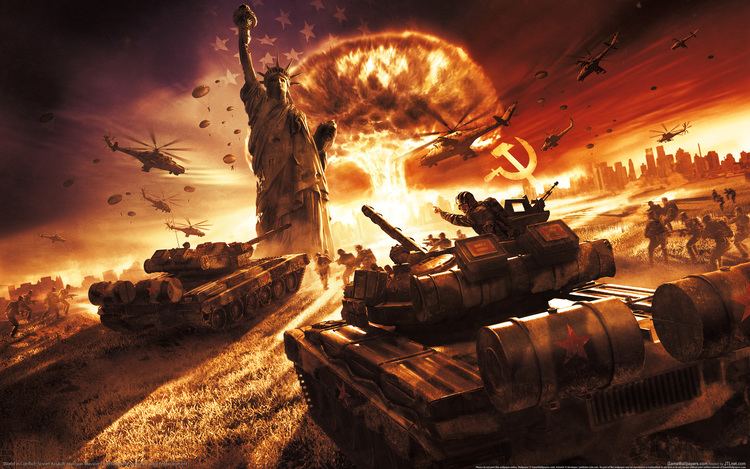
With the advent of the Cold War in 1947 and with the spread of nuclear weapons technology to the Soviet Union, the possibility of a third global conflict became more plausible. During the Cold War years the possibility of a Third World War was anticipated and planned for by military and civil authorities in many countries. Scenarios ranged from conventional warfare to limited or total Nuclear warfare. At the height of the Cold War, in a scenario referred to as MAD (Mutually Assured Destruction), it had been calculated that an all-out nuclear confrontation would most certainly destroy all or nearly all human life on the planet. The spectre of the potential of the absolute destruction of the human race may have contributed to the ability of both American and Soviet leaders to avoid such a scenario.
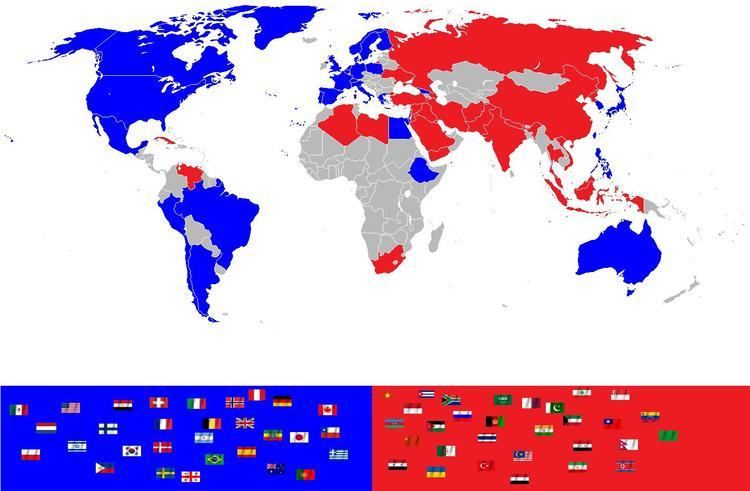
The Cold War ended in 1991 when the Soviet Union collapsed, leaving the United States as the sole global superpower. With the end of the Cold War, it was believed that the likelihood of a fully unrestricted nuclear confrontation between two superpowers was significantly diminished.
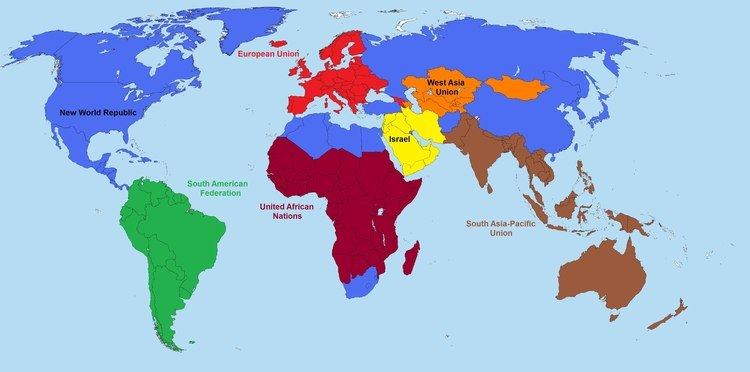
Military plans
Military planners have been war gaming various scenarios, preparing for the worst, since the early days of the Cold War. Some of those plans are now out of date and have been partially or fully declassified.
Operation Unthinkable
British Prime Minister Winston Churchill was concerned that, with the enormous size of Soviet forces deployed in Europe at the end of WWII and the unreliability of the Soviet leader Joseph Stalin, there was a serious threat to Western Europe. In April–May 1945, British Armed Forces developed Operation Unthinkable, thought to be the first scenario of the Third World War. Its primary goal was "to impose upon Russia the will of the United States and the British Empire". The plan was rejected by the British Chiefs of Staff Committee as militarily unfeasible.
Operation Dropshot
"Operation Dropshot" was the 1950s United States contingency plan for a possible nuclear and conventional war with the Soviet Union in the Western European and Asian theaters.
At the Time the US nuclear arsenal was limited in size, based mostly in the United States, and depended on bombers for delivery. Dropshot included mission profiles that would have used 300 nuclear bombs and 29,000 high-explosive bombs on 200 targets in 100 cities and towns to wipe out 85% of the Soviet Union's industrial potential at a single stroke. Between 75 and 100 of the 300 nuclear weapons were targeted to destroy Soviet combat aircraft on the ground.
The scenario was devised prior to the development of intercontinental ballistic missiles. It was also devised before Robert McNamara and President Kennedy changed the US nuclear war plan from the 'city killing' countervalue strike plan to "counterforce" (targeted more at military forces). Nuclear weapons at this time were not accurate enough to hit a naval base without destroying the city adjacent to it, so the aim in using them was to destroy the enemy industrial capacity in an effort to cripple their war economy.
Exercises Grand Slam, Longstep, and Mainbrace
In January 1950, the North Atlantic Council approved NATO's military strategy of containment. NATO military planning took on a renewed urgency following the outbreak of the Korean War in the early 1950s, prompting NATO to establish a "force under a centralised command, adequate to deter aggression and to ensure the defence of Western Europe". Allied Command Europe was established under General of the Army Dwight D. Eisenhower, US Army, on 2 April 1951. The Western Union Defence Organization had previously carried out Exercise Verity, a 1949 multilateral exercise involving naval air strikes and submarine attacks.
Exercise Mainbrace brought together 200 ships and over 50,000 personnel to practice the defence of Denmark and Norway from Russian attack in 1952. It was the first major NATO exercise. The exercise was jointly commanded by Supreme Allied Commander Atlantic Admiral Lynde D. McCormick, USN, and Supreme Allied Commander Europe General Matthew B. Ridgeway, US Army, during the Fall of 1952.
The US, UK, Canada, France, Denmark, Norway, Portugal, Netherlands, and Belgium all participated.
Exercises Grand Slam and Longstep were naval exercises held in the Mediterranean Sea during 1952 to practice dislodging an enemy occupying force and amphibious assault. It involved over 170 warships and 700 aircraft under the overall command of Admiral Carney. The overall exercise commander, Admiral Carney summarized the accomplishments of Exercise Grand Slam by stating: "We have demonstrated that the senior commanders of all four powers can successfully take charge of a mixed task force and handle it effectively as a working unit."
The USSR called the exercises "war-like acts" by NATO, with particular reference to the participation of Norway and Denmark, and prepared for its own military maneuvers in the Soviet Zone.
Operation Strikeback
This was a major NATO naval exercise held in 1957, simulating a response to an all-out Soviet attack on NATO. The exercise involved over 200 warships, 650 aircraft, and 75,000 personnel from the United States Navy, the United Kingdom's Royal Navy, the Royal Canadian Navy, the French Navy, the Royal Netherlands Navy, and the Royal Norwegian Navy. As the largest peacetime naval operation up to that time, Operation Strikeback was characterized by military analyst Hanson W. Baldwin of The New York Times as "constituting the strongest striking fleet assembled since World War II".
Exercise Reforger
Exercise Reforger (from return of forces to Germany) was an annual exercise conducted, during the Cold War, by NATO. The exercise was intended to ensure that NATO had the ability to quickly deploy forces to West Germany in the event of a conflict with the Warsaw Pact. The Warsaw Pact outnumbered NATO throughout the Cold War in conventional forces, especially armor. Therefore, in the event of a Soviet invasion, in order not to resort to tactical nuclear strikes, NATO forces holding the line against a Warsaw Pact armored spearhead would have to be quickly resupplied and replaced. Most of this support would have come across the Atlantic from the US and Canada.
Reforger was not merely a show of force—in the event of a conflict, it would be the actual plan to strengthen the NATO presence in Europe. In that instance, it would have been referred to as Operation Reforger. Important components in Reforger included the Military Airlift Command, the Military Sealift Command, and the Civil Reserve Air Fleet.
Seven Days to the River Rhine
Seven Days to the River Rhine was a top secret military simulation exercise developed in 1979 by the Warsaw Pact. It started with the assumption that NATO would launch a nuclear attack on the Vistula river valley in a first-strike scenario, which would result in as many as two million Polish civilian casualties. In response, a Soviet counter-strike would be carried out against West Germany, Belgium, the Netherlands and Denmark, with Warsaw Pact forces invading West Germany and aiming to stop at the River Rhine by the seventh day. Other USSR plans stopped only upon reaching the French border on day nine. Individual Warsaw Pact states were only assigned their own subpart of the strategic picture; in this case, the Polish forces were only expected to go as far as Germany. The Seven Days to the Rhine plan envisioned that Poland and Germany would be largely destroyed by nuclear exchanges, and that large numbers of troops would die of radiation sickness. It was estimated that NATO would fire nuclear weapons behind the advancing Soviet lines to cut off their supply lines and thus blunt their advance. While this plan assumed that NATO would use nuclear weapons to push back any Warsaw Pact invasion, it did not include nuclear strikes on France or the United Kingdom. Newspapers speculated when this plan was declassified, that France and the UK were not to be hit in an effort to get them to withhold use of their own nuclear weapons.
Exercise Able Archer
Exercise Able Archer was an annual exercise by the United States military in Europe that practiced command and control procedures, with emphasis on transition from solely conventional operations to chemical, nuclear, and conventional operations during a time of war.
"Able Archer 83" was a five-day North Atlantic Treaty Organization (NATO) command post exercise starting on 7 November 1983, that spanned Western Europe, centered on the Supreme Headquarters Allied Powers Europe (SHAPE) Headquarters in Casteau, north of the city of Mons. Able Archer exercises simulated a period of conflict escalation, culminating in a coordinated nuclear attack.
The realistic nature of the 1983 exercise, coupled with deteriorating relations between the United States and the Soviet Union and the anticipated arrival of strategic Pershing II nuclear missiles in Europe, led some members of the Soviet Politburo and military to believe that Able Archer 83 was a ruse of war, obscuring preparations for a genuine nuclear First Strike. In response, the Soviets readied their nuclear forces and placed air units in East Germany and Poland on alert. This "1983 war scare" is considered by many historians to be the closest the world has come to nuclear war since the Cuban Missile Crisis of 1962. The threat of nuclear war ended with the conclusion of the exercise on 11 November.
Strategic Defense Initiative
The Strategic Defense Initiative (SDI) was proposed by US President Ronald Reagan on 23 March 1983. In the later part of his presidency, numerous factors (which included watching the 1983 movie The Day After and hearing through a Soviet defector that Able Archer 83 almost triggered a Russian first strike) had turned Ronald Reagan against the concept of winnable nuclear war, and he began to see nuclear weapons as more of a "wild card" than a strategic deterrent. Although he later believed in disarmament treaties slowly blunting the danger of nuclear weaponry by reducing their number and alert status, he also believed a technological solution might allow incoming ICBMs to be shot down, thus making the US invulnerable to a first strike. However the USSR saw the SDI concept as a major threat, since unilateral deployment of the system would allow the US to launch a massive first strike on the Soviet Union without any fear of retaliation.
The SDI concept was to use ground-based and space-based systems to protect the United States from attack by strategic nuclear ballistic missiles. The initiative focused on strategic defense rather than the prior strategic offense doctrine of Mutual Assured Destruction (MAD). The Strategic Defense Initiative Organization (SDIO) was set up in 1984 within the United States Department of Defense to oversee the Strategic Defense Initiative.
NATO nuclear sharing
NATO operational plans for a Third World War have involved NATO allies who do not have their own nuclear weapons, using nuclear weapons supplied by the United States as part of a general NATO war plan, under the direction of NATO's Supreme Allied Commander.
Of the three nuclear powers in NATO (France, the United Kingdom and the United States), only the United States has provided weapons for nuclear sharing. As of November 2009, Belgium, Germany, Italy, the Netherlands and Turkey are still hosting US nuclear weapons as part of NATO's nuclear sharing policy. Canada hosted weapons until 1984, and Greece until 2001. The United Kingdom also received US tactical nuclear weapons such as nuclear artillery and Lance missiles until 1992, despite the UK being a nuclear weapons state in its own right; these were mainly deployed in Germany.
In peace time, the nuclear weapons stored in non-nuclear countries are guarded by US airmen though previously some artillery and missile systems were guarded by US Army soldiers; the codes required for detonating them are under American control. In case of war, the weapons are to be mounted on the participating countries' warplanes. The weapons are under custody and control of USAF Munitions Support Squadrons co-located on NATO main operating bases who work together with the host nation forces.
As of 2005, 180 tactical B61 nuclear bombs of the 480 US nuclear weapons believed to be deployed in Europe fall under the nuclear sharing arrangement. The weapons are stored within a vault in hardened aircraft shelters, using the USAF WS3 Weapon Storage and Security System. The delivery warplanes used are F-16s and Panavia Tornados.
Historical close calls
With the development of the arms race in the 1950s, an apocalyptic war between the United States and the Soviet Union was considered possible, and a number of events have been described as potential triggers for a nuclear conflict.
Cold War
Norman Podhoretz has suggested that the Cold War can be identified as World War III because it was fought, although by proxy, on a global scale, involving the United States, NATO, the Soviet Union and Warsaw Pact countries. Similarly, Eliot Cohen, the director of strategic studies at the Paul H. Nitze School of Advanced International Studies at Johns Hopkins University, declared, in The Wall Street Journal, that he considers World War III to be history, writing: "The Cold War was World War III, which reminds us that not all global conflicts entail the movement of multi-million-man armies, or conventional front lines on a map." On the 24 May 2011 edition of CNBC's Kudlow and Company, host Lawrence Kudlow, discussing a book by former deputy Under-Secretary of Defense Jed Babbin, accepted the view of the Cold War as World War III, adding, "World War IV is the terror war, and war with China would be World War V." However, not everyone accepts this definition of the Cold War as World War III. In his book Secret Weapons of the Cold War, Bill Yenne contends that "[the Cold War] was what occurred between the two 'Superpowers' – the United States and the Soviet Union – in lieu of World War III."
War on ISIL
On 1 February 2015, Iraq's Prime Minister declared that the War on ISIL was effectively "World War III", due to ISIS' declaration of a Worldwide Caliphate, its aims to conquer the world, and its success in spreading the conflict to multiple countries outside of the Levant region. In response to the November 2015 Paris attacks, King of Jordan Abdullah II said "We are facing a Third World War [within Islam].
In his State of the Union Address on 12 January 2016, US president Barack Obama warned that news reports granting ISIS the supposed ability to foment WW III might be excessive and irresponsible, stating that, "as we focus on destroying ISIL, over-the-top claims that this is World War III just play into their hands. Masses of fighters on the back of pickup trucks and twisted souls plotting in apartments or garages pose an enormous danger to civilians and must be stopped. But they do not threaten our national existence."
Multiple small wars as a "third war"
In a speech comparing the conflagrations of World Wars I and II to the ongoing lower intensity wars of the 21st century, Pope Francis stated, "The world is at war, because it has lost peace,.... perhaps one can speak of a third war, one fought piecemeal."
Views on the likely outcome and definition of WW III
In 1949, after the unleashing of nuclear weaponry at the end of WW II, physicist Albert Einstein suggested that any outcome of a possible WW III would be so dire as to minimally revert mankind back to the stone ages. When asked by journalist Alfred Werner, what types of weapons Einstein believed World War III might be fought with, Einstein warned, "I know not with what weapons World War III will be fought, but World War IV will be fought with sticks and stones."
